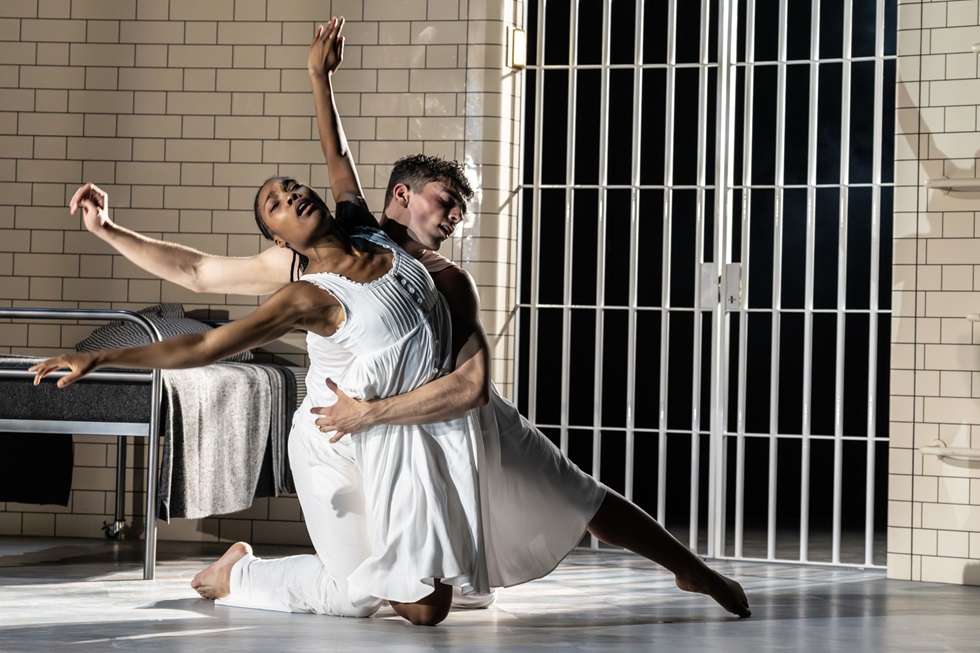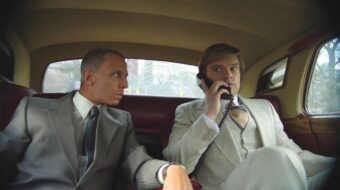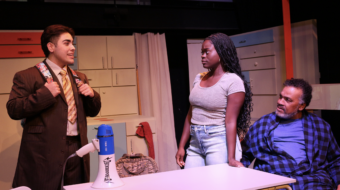
LOS ANGELES — I’d say, “Run, run, run,” but given that we’re talking ballet, I prefer “Skip, hop and leap” over to the Ahmanson Theatre, where, now through Feb. 25, you will experience one of the most joyous, life-affirming theatrical events not just of the season but perhaps of your life! No wonder The New Yorker calls Matthew Bourne “The most popular choreographer of theatrical dance in the western world.”
The Center Theatre Group/Ahmanson Theatre, in association with Glorya Kaufman Presents Dance at The Music Center, offers up the North American premiere of Romeo and Juliet that simply cannot be missed.
“I had resisted creating a new production of Romeo and Juliet for many years,” Bourne says, “wondering if there was anything new to say in a much-performed work. In 2019, I found that inspiration in a countrywide young talent development project that surrounded the original production. Working alongside my usual creative team, but with a team of young artistic associates and a young cast of super talented emerging dance artists, we created something relevant, questioning, and deeply moving—but also, an unexpected hit show.”
Music lovers hold Sergei Prokofiev’s original score, pulsating with physical yearning, among the highest ranks of 20th-century ballet music. Presented in three acts (two before intermission, one following) with a total running time of about two hours, the Bourne version uses an adapted, edgier score by frequent Bourne collaborator, “orchestrator” Terry Davies, who adds almost Kurt Weillian touches. All of Prokofiev’s themes and poignant harmonies are still there, but with a less “full symphony orchestra” sound, all prerecorded, and with added effects such as clanging alarms, bells, rain and thunder, a gunshot. Many symphonic music patrons know the score from the often programmed 35-minute Suite Prokofiev assembled as a concert piece (actually he compiled three such suites from the ballet).

The Romeo and Juliet story is not only about young love. As the whole world knows, it is also about the tragic outcome of irreconcilable family feuds, national, tribal, and racial enmity, irrational hatred toward the “other,” in Shakespeare’s play between the Capulets and the Montagues. The fact that the story has been adapted into countless versions and reinterpretations (West Side Story, of course) attests to the global recognition of the senselessness of superiority and inferiority within the human race. One early operatic treatment, in 1830, by bel canto composer Vincenzo Bellini, actually bore the title I Capuleti e i Montecchi.
It’s worth recalling that in Shakespeare’s play when we first meet Romeo, he is gushing to his friend how totally love-smitten he is—by Rosaline. But when he espies Juliet, he quickly transfers his overblown, ecstatic emotions to her. The romance would surely have blossomed, run its course, and lasted—or not—under normal (meaning erratically hormonal) adolescent conditions. What makes it tragic is the social context—the Hatfield and McCoy conflict in American terms—that makes it impossible for young love to flourish. Therefore, that context itself is lifted up to an essential plot element.
Prokofiev wrote his score in 1935, but it took until January of 1940 for it to reach the stage in the USSR—at the Kirov Theatre (now the Mariinsky) in Leningrad—a production that won international acclaim and received the Stalin Prize. The Soviets were enormously proud of their classical dance history and preserved the imperial style all through the Soviet period, adding contemporary work to the repertoire.
But consider the moment: World War II had just begun, with the September 1, 1939, German invasion of Poland. For the time being, the Soviets, who divided helpless Poland with Germany, enjoyed an uneasy peace with Germany that surely would not last long. Was Romeo and Juliet at that particular time an appeal to tone down the racial, national, and religious hatreds in Europe for fear of what further disaster might follow in its wake? Was it, too, an appeal for the 12 national republics of the USSR (15 later that year with the inclusion of the three Baltic states), plus all the autonomous regions, to pull together as one and not allow religious and ethnic differences to come to blows?
I don’t believe any of that was the overt, conscious agenda of the Romeo and Juliet ballet; I am only setting the context.
But theatergoers for the Bourne R&J will encounter a different context. The scene is set in a mental institution, where the inmates are as much prisoners as patients. Romeo, son of Senator Montague and his wife, is deposited there on account of his peculiar tics and behavioral patterns. But there is no contrasting “Capulet” tribe. Instead, the patients must deal with an authoritarian system of guards, walls, metal grates, a kind of medical fascism. The other patients, including Juliet, have a variety of undefined mental issues. Some are overtly homosexual, which, in the context of the time frame, could itself have been enough cause for institutionalization.
I couldn’t help thinking that Romeo, performed by a Caucasian dancer (Paris Fitzpatrick on opening night), and Juliet by a young Black dancer (Monique Jonas)—both British, as is Bourne’s New Adventures company and, I’m guessing, all or most of the rest of the cast—stood in for the racial/ethnic divide which the lovers tried to overcome. I can only assume many in the audience must have believed so too. But I was misguided—showing how much a viewer brings their own experience and assumptions into the theater with them. Because two other dancers are also on the roster for the role of Romeo, and likewise for Juliet, and this racial difference would not be apparent in other pairings. The official production photos show Ms. Jonas with Rory MacLeod.
In short, this R&J is neither a faithful replication in dance of the Shakespeare play, although many of the named characters do derive from it, nor of the Prokofiev scenario either. The principal focus of tension involves the universally hated head guard, whom we meet close to the top of the show as he relentlessly pursues Juliet, who does not return his interest. So her attraction to Romeo is as much a relief and flight from the armed rapist as it is attraction to the willowy teenager. We don’t actually get much sense of what the nature of Juliet’s particular malady is, but later in the show, she has a disturbing hallucination that more or less suggests her problem.
In any case, perhaps Bourne’s point is that these young people “in the not-too-distant future” are confined to the Verona Institute, a punitive sanatorium against their will, their families and the hospital in an unspoken pact to isolate them from society and even from one another on the inside. So to preserve their humanity in this white-tiled, white-uniformed, late-Victorian institutional setting, these inmates, focusing on our pair of young lovers, will risk and sacrifice all for their personal integrity and love. Only the softening, empathic presence of Rev. Bernadette Laurence (the Father Laurence of the play) relieves the relentless, soul-crushing environment of the institution.
Romeo and Juliet premiered in 2019 as the latest of Matthew Bourne’s 12 full-length stage projects, which have included such popular successes as Swan Lake, Cinderella, The Car Man—the latter his take on Carmen.
As to the dance itself, it is amalgamative by nature, encompassing classical technique alongside popular dance, ballroom, hip-hop, Apache, contemporary, jazz, interpretive, Broadway tai chi. No one needs to be a certified (or certifiable!) balletomane to appreciate the character and stunning variety of Bourne’s choreographic language.
The group scenes are a trademark of the work, not everyone doing the same precision movements at once but still, synchronized, conveying a sense of the whole ensemble. There are parts more like “acting” than dance per se, such as Romeo’s parents and various nurses, doctors, guards, yet they always mix into the physical expression of mood, place, and moment in any given scene.
Probably for any viewer, the pas de deux—the duets—between Romeo and Juliet will be retained in memory as the high points of the evening. Their hesitant meeting at the Verona Institute’s “prom,” leading to a star turn that amazes all and results in a round of applause from the other inmates. Except for the malevolent guard (who manifests the occasional homoerotic gesture as well), all accept the couple’s love and celebrate their acted-out marriage. As the drama ensues, R&J have many other occasions to express their love choreographically, sinuously exploring each other’s bodies in awed pleasure. In one scene the amorous couple are positively acrobatic in their love-making, all while sustaining a mouth-to-mouth kiss that to the naked eye would seem anatomically impossible.
A scene in which the drunken guard, clad in a black “wifebeater,” tries to break up the dance ends with all the inmates collectively subduing him like the Lilliputians tying Gulliver up. I almost heard the audience cheer.

The Institute features a balcony, stairways, and ladders, which make for any number of scenes set on and between different levels, at least four exit and entrance doors on stage level, and in different scenes, hospital bunk beds, chairs, and a pulpit. Everything on stage gets a complete workout.
Matthew Bourne directed and choreographed, collaborating with the New Adventures Artistic team: Etta Murfitt (Associate Artistic Director), Lez Brotherston (Set and Costume Design), Paule Constable (Lighting Design), Paul Groothuis (Sound Design) and Arielle Smith (Associate Choreographer), with the aforementioned Terry Davies’s adaptation of the Prokofiev score.
Sir Matthew Bourne was awarded the OBE (Order of the British Empire) for Services to Dance in 2001, followed by a Knighthood in 2016.
Matthew Bourne’s Romeo and Juliet runs through Sun., Feb. 25, with performances on Tues. through Fri. at 8 p.m., Sat. at 2 p.m. and 8 p.m., and Sun. at 1 p.m. and 6:30 p.m. A special Thurs. matinee takes place on Feb. 22 at 2 p.m. There’s no performance Weds., Feb. 7 or Sun. evening, Feb. 25. Tickets begin at $35 and are available at (213) 972-4400, in person at the Center Theatre Group Box Offices (at the Ahmanson Theatre), or at the CTG website. The Ahmanson Theatre is located at 135 N. Grand Ave., Los Angeles 90012. The Ahmanson posts an age guidance as 14 and up.
We hope you appreciated this article. At People’s World, we believe news and information should be free and accessible to all, but we need your help. Our journalism is free of corporate influence and paywalls because we are totally reader-supported. Only you, our readers and supporters, make this possible. If you enjoy reading People’s World and the stories we bring you, please support our work by donating or becoming a monthly sustainer today. Thank you!












Comments